| Article ID | Journal | Published Year | Pages | File Type |
|---|---|---|---|---|
| 2136134 | Journal of Bone Oncology | 2014 | 5 Pages |
AimsTo evaluate metastatic lesions within the radiation field using repeated magnetic resonance imaging (MRI) and to compare the imaging findings with pain response following radiotherapy (RT) in patients with spinal metastases (SM) from breast cancer.Material and methods32 Patients with SM from breast cancer admitted for fractionated RT were included in this study. MRI examinations of the spine were scored for the extent of bone metastases, epidural disease and the presence and severity of vertebral fractures. Clinical response was defined according to the updated international consensus on palliative RT endpoints.ResultsAt 2 and 6 months after RT, 38% and 44% of the patients were classified as responders. None of the patients developed motor deficits. Importantly, a decrease in the intraspinal tumor volume after RT was reported in all patients. Only 6% of the patients showed bone metastases progression within the RT field, whereas 60% of the patients showed disease progression outside the RT portals. 5 Patients developed new fractures after RT, and fracture progression was observed in 21 of the 38 lesions (55%). The pain response to RT did not correlate with the presence of vertebral body fracture before RT, fracture progression or other recorded MRI features of metastatic lesions.ConclusionRT provided excellent local tumor control in patients with SM. Most patients benefit from RT even in cases of progressive vertebral fracture. Pain response was not associated with imaging findings and MRI cannot be used to select patients at risk of not responding to RT.
